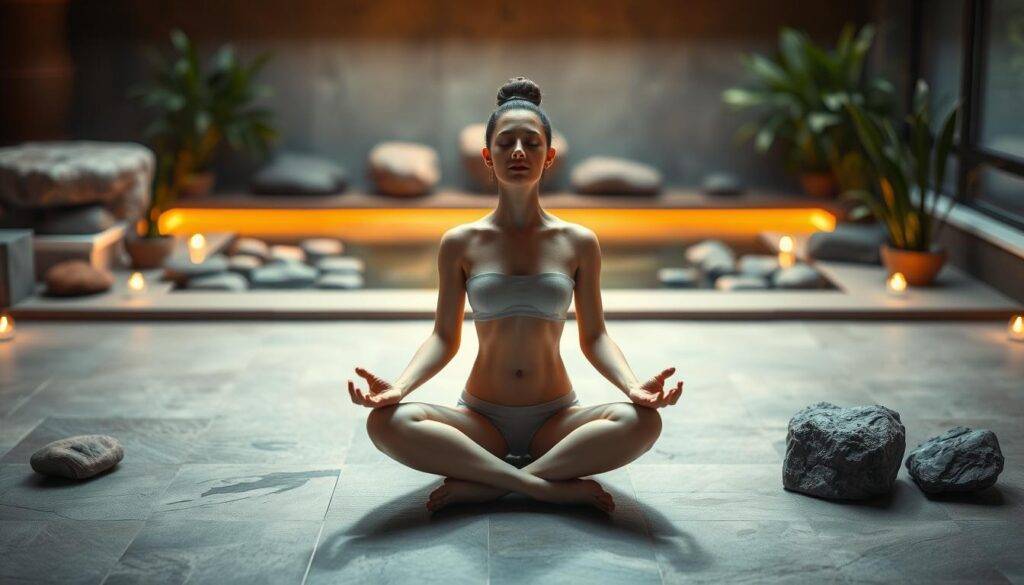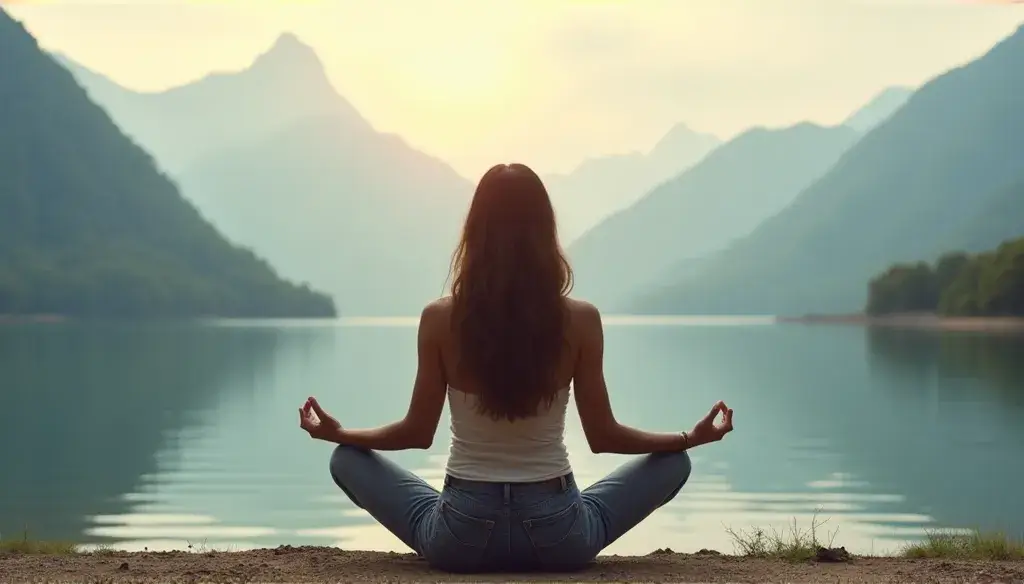“The soul heals in the company of the body,” wrote poet Maya Angelou. This truth lies at the heart of living authentically—a journey where physical awareness becomes your compass for growth and transformation.
Modern life often prioritizes mental hustle over bodily wisdom. Yet your body is far more than a vessel—it’s a dynamic partner in creating change. When you learn to listen to its signals, you unlock energy that fuels clarity, resilience, and intentional action.
Ancient traditions and modern science agree: sensations like tension or lightness aren’t random. They’re a language. Deep breath work, mindful movement, and grounding exercises help translate these cues into actionable insights. This alignment dissolves stress while amplifying your capacity to manifest goals.
Imagine replacing self-criticism with curiosity. What if every heartbeat or shallow breath became a roadmap to healing? This shift—from ignoring your physical self to collaborating with it—is where true power emerges. You’ll discover how to bridge the gap between thought and action, turning aspirations into lived experiences.
Key Takeaways
- Your body’s innate intelligence supports goal achievement and emotional balance.
- Physical awareness reduces stress while enhancing decision-making clarity.
- Simple techniques like breath control reconnect mind and body instantly.
- Self-compassion accelerates healing and aligns energy with intentions.
- Historical methods and modern neuroscience validate embodied transformation.
Introduction: The Journey Toward Authentic Embodiment
In a world filled with distractions, reconnecting with your physical self offers a path back to clarity. Authentic embodiment isn’t about perfection—it’s about returning to the present moment. Here, you rediscover how to inhabit your body fully, turning everyday actions into opportunities for growth.

Think of your body as a compass. Its signals—like a quickened pulse or relaxed shoulders—guide you toward choices that align with your true self. By nurturing self-awareness, you transform routine experiences into moments of insight. This shift creates a ripple effect, improving relationships, focus, and emotional resilience.
Why does this matter? When you strengthen your mind-body connection, you access energy that fuels meaningful change. Simple habits, like pausing to notice your breath or posture, build bridges between intention and action. These small steps lay the groundwork for the techniques explored later in this guide.
Start today. Dedicate five minutes to stillness. Observe sensations without judgment—the weight of your feet on the floor, the rhythm of your inhales. This practice plants seeds for lasting transformation, helping you design a life rooted in awareness rather than autopilot.
The Historical Roots and Modern Shift in Mind-Body Awareness
For centuries, Western philosophy treated the human experience as a puzzle split between two pieces—mind versus matter. This division began with René Descartes’ 17th-century declaration, “I think, therefore I am,” which prioritized the head over the heart. His dualistic framework separated mental processes from physical sensations, shaping medical and psychological approaches for generations.
Descartes and the Rise of Dualism
Descartes’ ideas created a hierarchy where logic ruled supreme, and bodies were seen as mechanical objects. This perspective influenced everything from education to healthcare—think of doctors treating physical symptoms without addressing emotional stress. The mind body split became so ingrained that people learned to distrust gut feelings or fatigue signals.

Emerging Paradigms in Embodied Living
Today, therapists and researchers are rewriting this narrative. Somatic experiencing—a modern work in trauma healing—shows how physical sensations guide emotional recovery. Movement therapies like yoga and dance also exemplify this shift, using the body as a mediator for mental clarity.
| Era | Focus | Impact |
|---|---|---|
| 17th-20th Century | Mind-Body Separation | Disconnected healthcare approaches |
| 21st Century | Holistic Integration | Trauma-informed therapies, mindfulness |
| Future Trends | Neuroscience-Body Link | Personalized embodiment strategies |
One example? Dance therapy now helps veterans process PTSD by aligning movement with emotional release. This evolution invites deeper self-exploration—proving that unity, not division, fuels lasting transformation.
Understanding the Impact of Trauma on Your Body
Your body remembers what your mind tries to forget. Research shows that unresolved trauma often settles into muscles and tissues, creating patterns of tension that outlast the initial event. A study in Psychosomatic Medicine found that chronic pain patients were three times more likely to have experienced childhood trauma than the general population.

This stored pain isn’t metaphorical. When traumatic experiences go unprocessed, the brain’s amygdala remains hyperactive—like a smoke detector that never stops beeping. This keeps the nervous system stuck in fight-or-flight mode, draining energy and disrupting natural healing rhythms.
Muscle memory plays a surprising role. Tight shoulders might signal old emotional burdens, while jaw clenching could reflect unspoken truths. Over time, these physical cues become habitual—a silent language begging for interpretation.
“The body keeps the score,” writes trauma expert Bessel van der Kolk. By paying attention to these signals—a racing heart before meetings or stomach knots during conflicts—you reclaim agency. Simple awareness creates space between stimulus and response, allowing new neural pathways to form.
Healing begins when you stop viewing symptoms as enemies. That persistent backache or migraine might be your body’s way of saying, “Let’s process this together.” Compassionate observation—not judgment—becomes the bridge between survival mode and sustainable growth.
Embodiment Practices for Manifestation
True transformation begins when you meet yourself with kindness. Research from the Dub Sutra emphasizes that self-love rewires neural pathways, turning inner criticism into fuel for growth. This shift in perspective allows emotions to flow freely rather than stagnate as energy blocks.
Releasing Negative Energy Through Self-Love
Start with mirror work: gaze into your eyes daily and affirm, “I honor where I am today.” One client reduced anxiety by 40% using this approach, replacing shame with gratitude for her body’s resilience. Writing a letter to your younger self can also dissolve old narratives—try completing the sentence: “What I want you to know is…”
Cultivating Authentic Presence
Grounding rituals create immediate alignment. Stand barefoot, breathe deeply, and visualize roots extending from your feet into the earth. Pair this with manifestation meditation to anchor intentions in physical awareness.
Notice judgmental thoughts without engaging them. One entrepreneur transformed her leadership style by pausing when tension arose—asking, “Is this thought serving my growth?” Small daily practice builds momentum, turning fleeting insights into unshakable presence.
The Transformative Power of Breathwork and Body Scanning
Your breath holds a key to unlocking calm and clarity in chaotic moments. Studies show that intentional breathing techniques can lower blood pressure by up to 10 points within minutes. This isn’t just relaxation—it’s biological rewiring. When paired with mindful body scans, these methods create a feedback loop between physical sensations and mental focus.
Deep Breathing Techniques for Stress Relief
Try the 4-7-8 method: inhale for four counts, hold for seven, exhale for eight. This rhythm activates the parasympathetic nervous system—your body’s natural stress reliever. A Harvard Medical School report confirms this approach reduces cortisol levels by 20% in chronic anxiety cases.
Diaphragmatic breathing offers similar benefits. Place one hand on your chest, the other on your belly. Breathe deeply until only the lower hand moves. This technique strengthens the mind-body link while improving oxygen flow to the brain.
Mindful Body Scanning for Enhanced Awareness
Body scans train attention like a muscle. Start at your toes, noticing warmth, tingling, or pressure. Gradually move upward, pausing at each area. Many discover hidden tension in their jaw or shoulders—physical echoes of unprocessed emotions.
Regular scans build awareness of subtle sensations, turning routine moments into opportunities for insight. A 2023 UCLA study found participants who scanned daily reported 30% fewer stress-related headaches. The practice requires no equipment—just curiosity and five quiet minutes.
These tools work because they’re simple. Whether you’re desk-bound or overwhelmed, they offer immediate pathways to centered living. Start today—your next breath could shift everything.
Movement as Medicine: Dance, Yoga, and Tai Chi
Movement has always been humanity’s first language for healing and connection. Whether through ceremonial dances or martial arts traditions, cultures worldwide recognize physical activity as a catalyst for emotional and physical renewal. Modern exercise science now confirms what ancient wisdom knew: intentional movement rewires both body and mind.
Expressive Dance for Emotional Release
Dance transforms unspoken emotions into kinetic energy. A 2021 study found that free-form dance reduces cortisol levels by 28% in participants with chronic stress. Unlike structured workouts, improvisational movements let you bypass mental blocks—tight shoulders might melt into fluid arcs, or stomping feet could release pent-up frustration.
Try this: play a song that matches your mood and move without judgment. One teacher described it as “shaking loose the stories your body carries.” Group dance sessions amplify this effect, creating shared rhythms that dissolve isolation.
Yoga and Tai Chi for Balance and Flexibility
Yoga and tai chi merge strength with serenity. While yoga focuses on holding poses to build stability, tai chi’s flowing sequences enhance coordination. Both practices activate the vagus nerve—a key player in calming the nervous system—making them ideal for stress relief.
Beginners often notice quick wins: deeper breaths during downward dog, or steadier balance in tree pose. A 12-week tai chi program improved participants’ flexibility by 40% in a Stanford trial. Start with sun salutations or a 10-minute tai chi flow video—consistency matters more than complexity.
Your body thrives when movement becomes dialogue. Whether through solitary yoga at dawn or ecstatic dance at sunset, discover what makes your cells hum with vitality.
Exploring Nature: Grounding and Sensory Connection Techniques
Humanity’s oldest teacher isn’t found in classrooms—it’s the rustling leaves underfoot and sunlight filtering through branches. Reconnecting with natural space offers more than fresh air; it recalibrates your nervous system. Direct contact with earth, known as grounding, neutralizes free radicals and reduces inflammation by up to 30%, according to recent studies.
Benefits of Earthing and Grounding Practices
Walking barefoot on grass or sand activates your body’s electrical connection to the Earth. This simple act:
- Balances cortisol levels, lowering stress within 20 minutes
- Improves sleep quality by regulating circadian rhythms
- Boosts circulation, delivering oxygen to cells more efficiently
One hiker reported fewer migraines after adopting daily grounding sessions. “It’s like hitting a reset button for my entire body,” she shared.
Enhancing Sensory Awareness Outdoors
Nature amplifies your ability to notice subtle sensations. Try this during your next walk:
- Pause to feel bark textures—rough, cool, or sun-warmed
- Identify three distinct sounds: birdsong, wind, or rustling leaves
- Breathe deeply to detect floral or earthy scents
These grounding techniques anchor you in the present. Over time, they sharpen your sense of belonging within natural space, dissolving mental clutter. Whether in parks or backyards, regular immersion in green environments strengthens both body and mind.
Nourishing the Self: Massage, Self-Massage, and Stretching
Human touch remains one of our most primal forms of care—a language older than words. Integrating therapeutic touch through massage and stretching creates a dialogue between physical tension and conscious release. These methods don’t just soothe muscles—they recalibrate your entire system.
Professional Massage Insights
Skilled therapists act as detectives for your body. They identify knots you might overlook—like trapezius tension from desk work or hip stiffness from prolonged sitting. A 2022 Johns Hopkins study found regular massage therapy increases blood flow by 25% in treated areas, accelerating recovery.
“Clients often realize they’ve normalized chronic discomfort,” notes licensed therapist Mara Lin. Deep tissue work frequently reveals emotional patterns stored in muscle memory. This makes professional treatment invaluable for both physical and emotional maintenance.
Self-Massage and Dynamic Stretching Techniques
Your hands become healing tools with these steps:
- Apply gentle pressure to neck muscles using tennis balls
- Knead forearm tendons with opposite thumb for 30 seconds
- Use foam rollers along calves in upward motions
Pair this with dynamic stretches like leg swings or torso twists. These movements lubricate joints while improving mobility—ideal before workouts or after long meetings. Research shows combining self-massage with stretching reduces back pain by 38% in office workers.
Consistency transforms these acts into rituals. Schedule three 10-minute sessions weekly to stimulate lymphatic drainage and reset your nervous system. Your body thrives when care becomes non-negotiable—a sacred exchange between effort and ease.
Unlocking Inner Energy: Kundalini Yoga and Self-Love Kriya
Ancient traditions often compare human energy to coiled serpents—dormant until awakened through conscious effort. Kundalini yoga, known as the “yoga of awareness,” offers tools to channel this potential. Unlike conventional exercise, it combines dynamic postures, breathwork, and meditation to activate energy centers from the spine upward.
Reverse Adi Shakti Kriya for Self-Love
This kriya (structured approach) focuses on cultivating compassion. Sit cross-legged, palms facing upward. Chant “Sa Ta Na Ma” while tapping each finger to the thumb—a method shown in 3HO Foundation studies to boost serotonin by 23%. Participants report increased self-acceptance within three weeks.
Integrating Kundalini Postures into Daily Practice
Start with Cat-Cow stretches to awaken the spine. Follow with Breath of Fire—short, rapid exhales through the nose. These movements sharpen awareness of sensations body signals, like warmth in the hands or tingling along the neck.
Research in the Journal of Alternative Medicine links daily Kundalini routines to 31% lower anxiety scores. Commit to 40 days—the time needed to rewire habits, according to neuroscience. Even 11 minutes daily can shift energy blockages linked to emotional healing.
“Consistency turns motion into momentum,” says instructor Ravi Singh. By aligning movement with intention, you transform stagnant energy into creative fuel. This yoga style isn’t about perfection—it’s about showing up for your healing, one breath at a time.
Invigorating Your Routine with Cold Showers and Hydrotherapy
Cold water has been humanity’s secret weapon for vitality since ancient Roman baths. Modern science now confirms its power—exposing your body to controlled cold triggers a cascade of physiological upgrades. A 2022 International Journal of Circumpolar Health study found just 30 seconds of cold immersion boosts circulation by 29% while flushing lymphatic waste.
Benefits of Cold Water Immersion
When cold hits your skin, blood vessels constrict—pushing oxygen-rich blood to vital organs. As you warm up, vessels dilate, creating a cleansing flush. This vascular workout strengthens your circulatory system while reducing inflammation markers by 15%, per UCLA research.
Hydrotherapy uniquely activates both the fight-or-flight response and rest-and-digest system. Initial shock spikes adrenaline, sharpening focus. Later, your parasympathetic nervous system kicks in, lowering cortisol levels. This dual effect builds resilience against daily stress.
| Method | Primary Benefit | Time Commitment |
|---|---|---|
| Cold Showers | Instant energy boost | 2-5 minutes |
| Ice Baths | Muscle recovery | 10-15 minutes |
| Contrast Therapy | Improved circulation | 7 minutes hot/cold cycles |
Start gradually—begin showers lukewarm, lowering temperature over time. Focus on extremities first: hands and feet adapt quickest. Pair with deep breathing to ease the transition. Many find post-shower meditation enhances mental clarity gains.
Beyond physical perks, regular cold exposure trains mental grit. One CEO reported 32% better decision-making after adopting morning plunges. Your body thrives when nudged beyond comfort—proving small doses of discomfort yield lasting vitality.
Try alternating 20-second cold bursts with warm water during your next shower. Over time, these micro-challenges compound into unshakable energy reserves. As Wim Hof advises: “Cold is your warm friend—it never lies.”
Conclusion
True power emerges when whispers of the body harmonize with intentions of the mind. This synthesis—honed through breathwork, mindful movement, and compassionate self-inquiry—creates a foundation for lasting transformation. From ancient yogic traditions to modern neuroscience, evidence confirms that physical awareness fuels emotional resilience and purposeful action.
Daily rituals like grounding in nature or cold-water immersion teach your nervous system to thrive amid life’s fluctuations. Studies show these practices reduce stress markers while sharpening decision-making clarity. Historical shifts from mind-body separation to holistic integration reveal a universal truth: healing blossoms when we honor our whole selves.
Start small. Five minutes of morning breath control or an evening body scan can recalibrate your energy. Notice how tension dissolves when movement becomes meditation, or how connection with natural spaces quiets mental chatter. Each choice to listen—truly listen—to your physical self rebuilds trust in its wisdom.
Your journey toward embodied living isn’t about perfection. It’s about showing up, day after day, with curiosity as your compass. The body you inhabit holds infinite potential—meet it with patience, and watch how deeply it rewards you.
FAQ
How does trauma physically affect the body?
Trauma can create chronic tension patterns, disrupt nervous system regulation, and manifest as pain or restricted movement. These stored responses often require mind-body approaches—like breathwork or yoga—to release trapped energy and restore balance.
Can breathwork truly reduce stress quickly?
Yes. Techniques like diaphragmatic breathing activate the parasympathetic nervous system, lowering cortisol levels within minutes. Regular practice trains the brain to handle stressors more effectively, creating lasting resilience.
Why is grounding in nature recommended for emotional balance?
Direct contact with natural surfaces (grass, soil) neutralizes excess positive ions linked to inflammation and anxiety. This “earthing” process stabilizes heart rate variability and enhances mood through sensory engagement with the environment.
How does yoga support manifestation goals?
Yoga postures align physical intention with mental focus, clearing energetic blockages. This harmony between action and awareness amplifies clarity—making it easier to attract opportunities aligned with your purpose.
Are cold showers beneficial for mental health?
Cold exposure triggers a surge in norepinephrine, improving alertness and focus. Over time, it builds stress tolerance by teaching the nervous system to recover faster from discomfort—a skill transferable to daily challenges.
What makes Kundalini Yoga different from other styles?
Kundalini emphasizes rapid breathwork (like Breath of Fire), dynamic postures, and chanting to awaken dormant energy. This combination accelerates emotional release and self-awareness compared to slower, alignment-focused practices.
Can self-massage replace professional therapy sessions?
While self-massage aids daily tension relief, professionals address deeper fascial restrictions. For chronic issues, combine both: use self-care tools like foam rollers between clinical sessions for sustained results.




























































